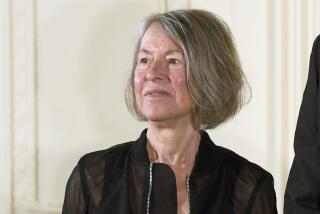Audrey Geisel, Dr. Seuss’ widow and noted philanthropist, dies at 97
Reporting from San Diego — Before popular children’s author Theodor “Dr. Seuss” Geisel died in 1991, he told his wife, Audrey, that she would be “the one who would have to live with all the critters and move them on.”
That she did, shepherding his legendary menagerie — the Cat in the Hat, the Grinch, Horton, the Lorax — into the 21st century, where it continues to entertain new generations of youngsters.
Audrey Geisel died Wednesday at her home in La Jolla. She was 97.
Petite and often understated, she was a fierce protector of her husband’s creations and legacy, and a major donor to institutions he supported and helped to flourish, including UC San Diego and the San Diego Zoo.
Born Audrey Stone in Chicago on Aug. 14, 1921, she grew up in a household jostled by hard times. Her father disappeared when she was young and she grew up living with her mother, or family friends, or, at one time, in foster care.
She met her first husband, cardiologist E. Grey Dimond, while she was working as a nurse at Massachusetts General Hospital in Boston. They had two daughters.
In 1960, the Dimonds moved to La Jolla, where they eventually came to know Ted Geisel and his first wife, Helen, socially. After both marriages ended, Ted and Audrey were wed in 1968.
Audrey Geisel is sometimes credited with moving her husband to address more social issues in his books, such as “The Lorax,” which has environmental themes, and “The Butter Battle Book,” an anti-war story.
She told him he wasn’t just writing for children anymore — the kids he first entertained had grown up and were now reading his stories to their own offspring.
After his death in 1991 at age 87, the city held a tribute to Geisel in Balboa Park, where his wife talked about his legacy in a way that foreshadowed her subsequent efforts to protect and promote his work.
“His name never comes up when you’re talking about the underbelly of the world,” she told the Union-Tribune. “It is always used when you’re talking about the good, the best of the world.”
A year later, she donated more than 4,000 items — original drawings and manuscripts, college notebooks, letters — to the library at UC San Diego, expanding his reach from popular culture into the world of academic research.
“His Seuss history,” she later explained, “will be preserved for posterity.”
More donations over the years have created a repository that is a must-visit for scholars looking to understand the author’s creative process and his enduring influence on children’s literature. The collection is housed in the Geisel Library, so named after a $20-million donation from Audrey Geisel in 1995.
Counterfeiters who thought Seuss’ death gave them free reign to copy his iconic images on T-shirts or posters soon found that they were mistaken. His widow’s attorneys aggressively went after them for copyright infringement. One 1993 suit brought a $750,000 judgment against an Oxnard wholesaler.
When anti-abortion groups started using a “Horton Hears a Who!” line — “A person’s a person, no matter how small” — she took issue with that, too.
“Ted never allowed his work to be used for political purposes,” she told the Union-Tribune in 2008.
The ongoing popularity of Seuss — his four-dozen books have sold more than 650 million copies worldwide — also created steady interest in film and theater adaptations and related merchandise. Seuss Enterprises, based in La Jolla, was set up to license the use of the characters.
Not all of the projects have been well received critically, but they have been lucrative. Forbes estimated the Theodor Geisel estate’s earnings over the past year at $16 million, placing him sixth on the magazine’s list of highest-paid deceased celebrities, just behind Bob Marley and ahead of Hugh Hefner.
As new commercial proposals came in, Geisel was often involved in the decision-making. During the production of an animated “Horton” movie 10 years ago, for example, she insisted certain things be changed. Horton’s teeth were too big, she believed. The kangaroo’s pouch hung too low.
She also had a hand in discovering “lost” Seuss manuscripts as she went through the mountain of material he left behind in desk drawers and closets. That led to the publication of “What Pet Should I Get?” in 2015.
“I totally, wonderfully approve of anything that comes to light at this time of Ted’s work,” Geisel said in a 2011 interview.
Survivors include her daughters, Leagrey Dimond and Lark Grey Dimond-Cates.
Services are pending.
Wilkens writes for the San Diego Union-Tribune.
More to Read
Sign up for Essential California
The most important California stories and recommendations in your inbox every morning.
You may occasionally receive promotional content from the Los Angeles Times.











